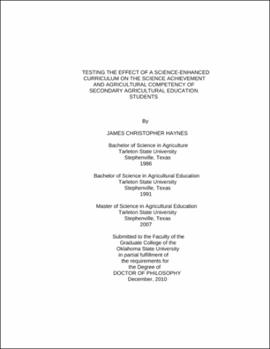| dc.contributor.advisor | Robinson, J. Shane | |
| dc.contributor.author | Haynes, James Christopher | |
| dc.date.accessioned | 2013-11-26T08:22:19Z | |
| dc.date.available | 2013-11-26T08:22:19Z | |
| dc.date.issued | 2010-12 | |
| dc.identifier.uri | https://hdl.handle.net/11244/6560 | |
| dc.description.abstract | Scope and Method of Study: The purpose of this study was to determine if a science-enhanced curriculum produced by the Center for Agricultural and Environmental Research and Training (CAERT) taught in a secondary level animal science or horticulture course would improve students' understanding of selected scientific principles significantly, when compared to students who were instructed using a traditional curriculum. A secondary purpose was to determine the effect that the science-enhanced CAERT curriculum would have on students' agricultural knowledge when compared to students who were instructed using a traditional curriculum. The design of the study was ex post facto, causal comparative because no random assignment of the treatment group occurred. | |
| dc.description.abstract | Findings and Conclusions: No statistically significant difference was found between the treatment and comparison groups regarding science achievement. However, the mean score of the treatment group was slightly larger than the comparison group indicating a slightly higher achievement level; a "Small" effect size (d = .16) for this difference was calculated. It was determined that a statistically significant difference (p < .05) existed in agriculture competency scores in animal science (p = .001) and horticulture (p = .000) as a result of the treatment. Moreover, this was considered to be a "very large" effect (d = 1.18) in animal science and a "large" effect (d = .92) in horticulture. When considering student achievement in science, this study found that the use of the science-enhanced CAERT curriculum did not result in a statistically significant increase (p < .05) in student performance as determined by the TerraNova3 science proficiency examination. However, students who were instructed using the CAERT curriculum, scored better overall than those who were instructed using a "traditional" curriculum. | |
| dc.format | application/pdf | |
| dc.language | en_US | |
| dc.rights | Copyright is held by the author who has granted the Oklahoma State University Library the non-exclusive right to share this material in its institutional repository. Contact Digital Library Services at lib-dls@okstate.edu or 405-744-9161 for the permission policy on the use, reproduction or distribution of this material. | |
| dc.title | Testing the effect of a science-enhanced curriculum on the science achievement and agricultural competency of secondary agricultural education students | |
| dc.contributor.committeeMember | Edwards, J. Craig | |
| dc.contributor.committeeMember | Key, James P. | |
| dc.contributor.committeeMember | Self, Mary Jo | |
| osu.filename | Haynes_okstate_0664D_11280 | |
| osu.accesstype | Open Access | |
| dc.type.genre | Dissertation | |
| dc.type.material | Text | |
| dc.subject.keywords | causal comparative | |
| dc.subject.keywords | curriculum | |
| dc.subject.keywords | quasi experimental | |
| dc.subject.keywords | science | |
| dc.subject.keywords | secondary education | |
| dc.subject.keywords | stem | |
| thesis.degree.discipline | Agricultural Education | |
| thesis.degree.grantor | Oklahoma State University | |
